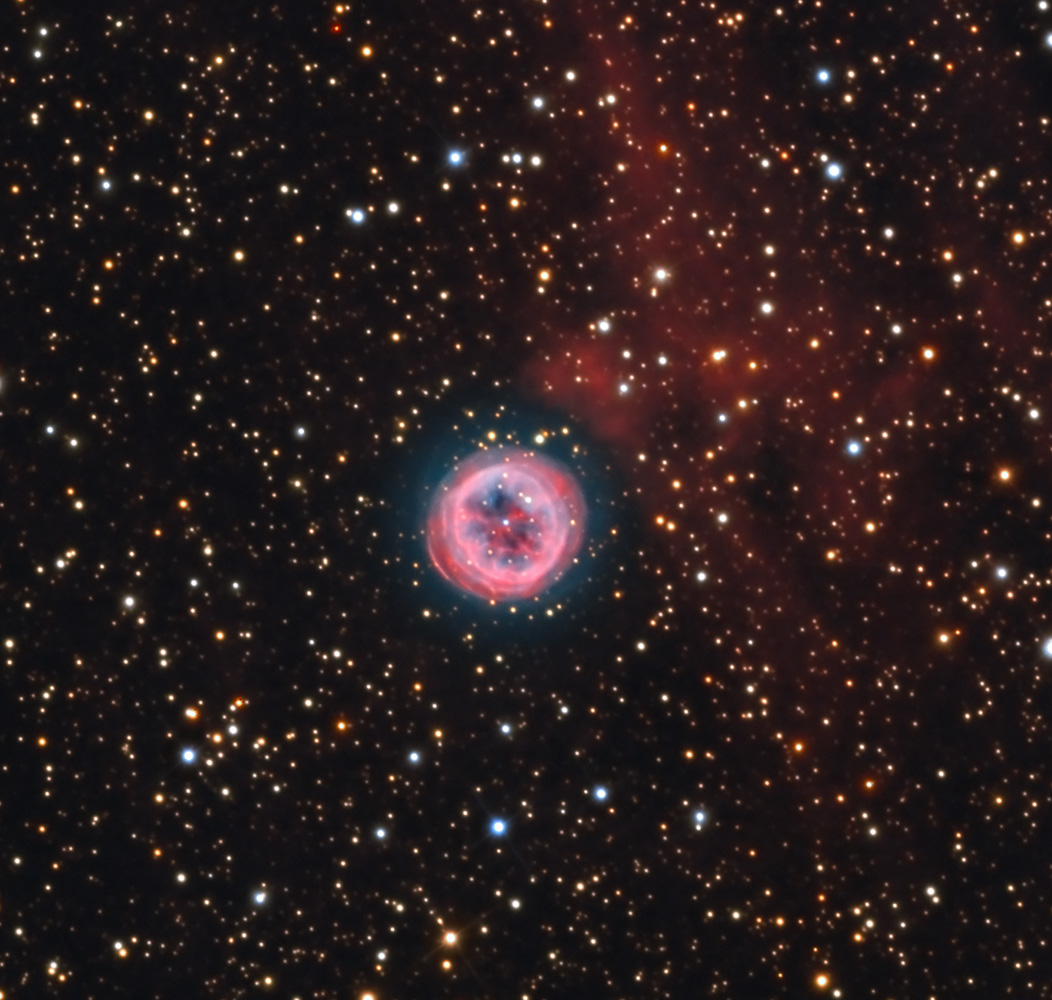Blog

The sparkling scene depicted in this week’s Hubble Picture of the Week is of the spiral galaxy NGC 5248, located 42 million light-years from Earth in the constellation Boötes. It is also known as Caldwell 45, having been included in a catalogue of visually interesting celestial objects that were known, but weren’t as commonly observed by amateur astronomers as the more famous Messier objects.
NGC 5248 is one of the so-called ‘grand design’ spirals, with prominent spiral arms that reach from near the core out through the disc. It also has a faint bar structure in the centre, between the inner ends of the spiral arms, which is not quite so obvious in this visible-light portrait from Hubble. Features like these which break the rotational symmetry of a galaxy have a huge influence on how matter moves through it, and eventually its evolution through time. They feed gas from a galaxy’s outer reaches to inner star-forming regions, and even to a galaxy’s central black hole where it can kick-start an active galactic nucleus.
These flows of gas have shaped NGC 5248 in a big way; it has many bright ‘starburst regions’ of intense star formation spread across its disc, and it is dominated by a population of young stars. The galaxy even has two very active, ring-shaped starburst regions around its nucleus, filled with young clusters of stars. These ‘nuclear rings’ are remarkable enough, but normally a nuclear ring tends to block gas from getting further into the core of a galaxy. NGC 5248 having a second ring inside the first is a marker of just how forceful its flows of matter and energy are! Its relatively nearby, highly visible starburst regions make the galaxy a target for professional and amateur astronomers alike.

Yo-Yo Ma (born October 7, 1955) is an American cellist. Born to and partially raised by Chinese parents in Paris and educated in New York City, he was a child prodigy, performing from the age of four and a half. He graduated from the Juilliard School and Harvard University, attended Columbia University, and has performed as a soloist with orchestras around the world. He has recorded more than 92 albums and received 19 Grammy Awards.
In addition to recordings of the standard classical repertoire, Ma has recorded a wide variety of folk music, such as American bluegrass music, traditional Chinese melodies, the tangos of Argentine composer Astor Piazzolla, and Brazilian music. He has also collaborated with artists from a diverse range of genres, including Bobby McFerrin, Carlos Santana, Chris Botti, Diana Krall, James Taylor, Miley Cyrus, and Sting.
Ma has been a United Nations Messenger of Peace since 2006. He has received numerous awards, including the Avery Fisher Prize in 1978, The Glenn Gould Prize in 1999, the National Medal of Arts in 2001, the Presidential Medal of Freedom in 2011, Kennedy Center Honors in 2011, the Polar Music Prizein 2012, and the Birgit Nilsson Prize in 2022. He was named as one of Time‘s 100 Most Influential People of 2020.
Ma’s primary performance instrument is the Davidov cello, made in 1712 by Antonio Stradivari.
more...Mel Brown (October 7, 1939 – March 20, 2009) was an American-born blues guitarist and singer. He is best remembered for his decade-long backing of Bobby Bland, although in his own right Brown recorded over a dozen albums between 1967 and 2006.
Brown was born in Jackson, Mississippi, United States, and was presented with his first guitar as a teenager while recovering from a bout of meningitis. By 1955, after performing backing duties for both Sonny Boy Williamson II and Jimmy Beasley, Brown had a two year long stint backing Johnny Otis. This led to work with Etta James, where he swapped his Gibson Les Paul for an ES-175 to give him a richer and fuller tone to his guitar work, that set him apart from his contemporaries.
The stress of constant touring led him to Los Angeles, California, to resume work with Otis, spending an extended residency at the Club Sands. Further session duties saw Brown back Bobby Darin and Bill Cosbyamong others, as well as performing on T-Bone Walker‘s Funky Town. ABC Records producer Bob Thiele offered Brown the chance to record his own material, and Brown released Chicken Fat in 1967. Though principally a blues musician, Brown would also transition into jazz and soul jazz through his association with Bob Thiele, including a prominent role with the Oliver Nelson Big Band and appearing on Live from Los Angeles (released by Impulse!).
more...
Larry Young (also known as Khalid Yasin [Abdul Aziz]; October 7, 1940 – March 30, 1978) was an American jazz organist and occasional pianist. Young’s early work was strongly influenced by the soul jazzof Jimmy Smith, but he later pioneered a more experimental, modal approach to the Hammond B-3. Born and raised in Newark, New Jersey, United States, Young attended Newark Arts High School, where he began performing with a vocal group and a jazz band. He was also the cousin of the drummer Jimmie Smith.
Young played with various R&B bands in the 1950s, before gaining jazz experience with Jimmy Forrest, Lou Donaldson, Kenny Dorham, Hank Mobley and Tommy Turrentine. Recording as a leader for Prestigefrom 1960, Young made a number of soul jazz discs, Testifying, Young Blues and Groove Street. When Young signed with Blue Note around 1964, his music began to show the marked influence of John Coltrane. In this period, he produced his most enduring work. He recorded several times as part of a trio with guitarist Grant Green and drummer Elvin Jones, who were occasionally augmented by additional players. Most of these albums were released under Green’s name, though Into Somethin’ (with Sam Riverson saxophone) became Young’s Blue Note debut. Unity, recorded in 1965, remains his best-known album; it features a front line of Joe Henderson and the young Woody Shaw. Subsequent albums for Blue Note (Contrasts, Of Love and Peace, Heaven On Earth, Mother Ship) also drew on elements of the 1960s avant-garde and utilised local musicians from Young’s hometown of Newark. Young then became a part of some of the earliest fusion groups: first on Emergency! with the Tony Williams Lifetime (with Tony Williams and John McLaughlin) and also on Miles Davis‘s Bitches Brew. His sound with Lifetime was made distinctive by his often very percussive approach and regular heavy use of guitar and synthesizer-like effects. He is also known for a jam he recorded with rock guitarist Jimi Hendrix, which was released after Hendrix’s death on the album, Nine to the Universe.
In March 1978, he checked into a hospital for stomach pains. He died there on March 30, 1978, while being treated for what is said to be pneumonia.However, the actual cause of his death is unclear.
more...Jonathan David Samuel Jones (October 7, 1911 – September 3, 1985) was an American jazz drummer. A band leader and pioneer in jazz percussion, Jones anchored the Count Basie Orchestra rhythm section from 1934 to 1948. He was sometimes known as Papa Jo Jones to distinguish him from younger drummer Philly Joe Jones. Born in Chicago, Illinois, United States, Jones moved to Alabama, where he learned to play several instruments, including saxophone, piano, and drums. He worked as a drummer and tap-dancer at carnival shows until joining Walter Page‘s band, the Blue Devils in Oklahoma City in the late 1920s. He recorded with trumpeter Lloyd Hunter‘s Serenaders in 1931, and later joined pianist Count Basie‘s band in 1934. Jones, Basie, guitarist Freddie Green and bassist Walter Page were sometimes billed as an “All-American Rhythm section,” an ideal team. Jones took a brief break for two years when he was in the military, but he remained with Basie until 1948. He participated in the Jazz at the Philharmonic concert series.
He was one of the first drummers to promote the use of brushes on drums, and shifting the role of timekeeping from the bass drum to the hi-hat cymbal. Jones had a major influence on later drummers such as Buddy Rich, Kenny Clarke, Roy Haynes, Max Roach, and Louie Bellson. He also starred in several films, most notably the musical short Jammin’ the Blues (1944).
more...The planetary nebula NGC 6894 was discovered by William Herschel on 17th July 1784. With an angular diameter of around 40 arc minutes, it appears about as large as Jupiter, but is much fainter: around 14 magnitudes. The distance is about 1669 pc (about 5400 light years).

Millicent Dolly May Small CD (6 October 1947 – 5 May 2020) was a Jamaican singer who is best known for her international hit “My Boy Lollipop” (1964). The song reached number two in both the UK and US charts and sold over seven million copies worldwide. It was also the first major hit for Island Recordsand helped to achieve the label its mainstream success. She was the Caribbean’s first international recording star and its most successful female performer. Millicent Dolly May Small was born on 6 October 1947 in Clarendon, Jamaica, the daughter of a sugar plantation overseer. She was one of 13 siblings, with seven brothers and five sisters. Like many Jamaican singers of the era, her career began by winning the Vere Johns Opportunity Hour talent contest at the age of twelve. Wishing to pursue a career as a singer, she moved to live with relatives in Love Lane in Kingston. She auditioned for Studio One record producer Coxsone Dodd, who was struck by the similarity of her voice to that of Shirley Goodman of the American duo Shirley and Lee. He paired her with singer Owen Gray, and they made several records together, including “Sugar Plum”, which became a local hit.
more...Tony Oladipo Allen (20 July 1940 – 30 April 2020) was a Nigerian and French drummer, composer, and songwriter who lived and worked in Paris, France. Allen was the drummer and musical director of Fela Kuti‘s band Africa ’70 from 1968 to 1979, and was one of the founders of the Afrobeat genre. Fela once stated that “without Tony Allen, there would be no Afrobeat”. He was described by Brian Eno as “perhaps the greatest drummer who has ever lived”. Later in life, Allen collaborated with Damon Albarn on several projects, including Gorillaz, the Good, the Bad & the Queen and Rocket Juice & the Moon.
Allen was born in Lagos, Nigeria to James Alabi Allen, a motor mechanic from British Nigeria (now present day Nigeria) and Prudentia Mettle, from the Gold Coast (now present day Ghana). He began playing drums at the age of 18, while working as an engineer for a radio station. Allen was influenced by music his father listened to: Jùjú, a popular Yoruba music from the 1940s, but also American jazz, and the growing highlife scene in Nigeria and Ghana. Allen worked hard to develop a unique voice on the drums, feverishly studying LPs and magazine articles by Max Roach and Art Blakey, but also revolutionary Ghanaian drummer Guy Warren (later known as Kofi Ghanaba – who developed a highly sought-after sound that mixed tribal Ghanaian drumming with bop – working with Dizzy Gillespie, Charlie Parker, Thelonious Monk, and Max Roach).
Allen was hired by “Sir” Victor Olaiya to play claves with his highlife band, the Cool Cats. Allen was able to fill the drum set chair when the former Cool Cats drummer left the band. Allen later played with Agu Norris and the Heatwaves, the Nigerian Messengers, and the Melody Makers.
more...Samuel Blythe Price (October 6, 1908 – April 14, 1992) was an American jazz, boogie-woogie and jump blues pianist and bandleader. Price’s playing is dark, mellow, and relaxed rather than percussive, and he was a specialist at creating the appropriate mood and swing for blues and rhythm and blues recordings. Price was born in Honey Grove, Texas, United States. Price formally studied the piano with Booker T. Washington‘s daughter, Portia Marshall Washington (1883–1978). In the mid-1920s, when he was employed in a Dallas music store, Price wrote to Paramount Records recommending Blind Lemon Jefferson to the label.
During his early career, he was a singer and dancer in local venues in the Dallas area. Price lived and played jazz in Kansas City, Chicago and Detroit. In 1938 he was hired by Decca Records as a sessionsideman on piano, assisting singers such as Trixie Smith and Sister Rosetta Tharpe. Price’s trio accompanied Rosetta Tharpe and Marie Knight on many of their gospel recordings such as “Up Above My Head” and “Two Little Fishes and Five Loaves of Bread.”
more...Frank Craig Chicago Blues guitar player.
Born: October 5, 1935 in Greenville, MS
Died: January 14, 1992 in Los Angeles, CA
Left Hand Frank was a fun loving, powerfully built bluesman who liked to amuse audiences in Chicago’s South Side blues clubs with comical Donald Duck imitations and muscle-flexing tricks. But what crowds enjoyed even more was the way Frank Craig played guitar. Employing a confident, four-fingered picking style, he played his axe upside down, like several other left-handed bluesmen, with the treble strings at the top. And he played some of the strongest, most distinctive vintage blues to be heard in Chicago.
Frank worked in countless bands during his nearly 40 years in Chicago. He was probably the best musician in most of those groups. But until 1978, Frank never played guitar or sang on a record. Frank found that it was more fun to be a sideman, and he never thought much about becoming a headliner or leading a band.
“Mainly, I don’t like to be worried with it,” Frank explained. “I’ve had quite a few jobs myself, but guys don’t want to act right. It’s too much of a headache. I’d switch over and put that headache on somebody else. I hate to have a headache.”
So Frank left the band leading headaches to bluesmen like Junior Wells, Little Walter, Hound Dog Taylor, and Willie Cobbs. Frank was happy just to play guitar or bass as part of someone else’s band.
When Frank started playing in his hometown of Greenville, Mississippi, he didn’t even have to worry about bands. He could stroll the streets, playing by himself to earn tips from passersby. He got his first guitar on his fourth birthday, October 5, 1939, and quickly learned both blues and country & western from older musicians who were always at his house buying homebrewed corn whiskey from Frank’s mother. Before moving to Chicago at the age of 14, young Frank performed at the local sheriff’s parties, at the local fairgrounds, and around the countryside, carrying his guitar with him on the bus and playing wherever people would pay to see such a child prodigy.
During the early ‘50s in Chicago, Frank was still a street and house party musician, too young to be allowed in the taverns. But he lived within a block of two blues clubs, The Zanzibar and Vi’s Lounge. Frank and two teenaged friends, guitarist Eddie King and bassist Willie Black, eagerly listened at the door whenever Muddy Waters, Little Walter, Memphis Slim or Howlin’ Wolf were performing. After some intense rehearsals, the trio started playing outside The Zanzibar and Vi’s, sharing wine and whiskey with the onlookers. “We’d have a bigger crowd outside than they did inside!” Frank would laugh.
Willie Cobbs, originator of the blues standard “You Don’t Love me,” hired the young bluesmen (who had boldly named themselves the Chicago All-Stars) to work with him in the West Side clubs and on the road. Jimmy Rogers and Lee Jackson let Frank sit in on bass at The Squeeze Club, and in the mid-‘50s, Frank began a long association with his steadiest employer, guitarist James Scott, Jr., at Joe’s 1015 Club on 43rd Street. There were also gigs with Jimmy Dawkins at The Pink Poodle, with Delta bluesman Boyd Gilmore in Pine Bluff, Arkansas, and with Good Rockin’ Charles at a West Side club where the crowds “barn danced” to Frank’s country breakdowns. In the ‘60s, Frank, who was working as a manual laborer during the daytime, played with Junior Wells, Junior Simpkins, Willie Williams, Carey Bell, Little Arthur Gray, Hound Dog Taylor, Little Walter and others, including Willie Cobbs and James Scott again at times. Frank recorded, as a bass player, on an Eddie King single in 1960 and on later sessions behind Morris Pejoe, Little Eddie Newell and Willie Williams.
Frank was just as active, and just as sought after by various bandleaders, in the ‘70s. He was a regular with Johnny Bernard’s group at Louise’s, Porter’s, and other South Side clubs, and continued to work on and off with James Scott. He was a familiar face at the famed Sunday afternoon jam sessions at Florence’s, where Hound Dog Taylor held forth for years. In the late ‘70s, Frank teamed up with two young white newcomers, Dimestore Fred and Pocketwatch Paul, who appeared on his recording debut on Alligator’s Living Chicago Blues series. Frank’s session proved him to be totally rooted in the raw, Delta-based Chicago style of the 1950s, bringing to mind his friends Magic Slim, Jimmy Rogers and Brewer Phillips.
In the 1980s, Frank moved to Los Angeles to live with his sister. His declining health and a series of surgeries led to his abandoning music, and he eventually died in California. An album of a live performance is still in print on a French label.
more...While hunting for comets in the skies above 18th century France, astronomer Charles Messier diligently kept a list of the things encountered during his telescopic expeditions that were definitely not comets. This is number 27 on his now famous not-a-comet list. In fact, 21st century astronomers would identify it as a planetary nebula, but it’s not a planet either, even though it may appear round and planet-like in a small telescope. Messier 27 (M27) is an excellent example of a gaseous emission nebula created as a sun-like star runs out of nuclear fuel in its core. The nebula forms as the star’s outer layers are expelled into space, with a visible glow generated by atoms excited by the dying star’s intense but invisible ultraviolet light. Known by the popular name of the Dumbbell Nebula, the beautifully symmetric interstellar gas cloud is over 2.5 light-years across and about 1,200 light-years away in the constellation Vulpecula. This impressive color image highlights details within the well-studied central region and fainter, seldom imaged features in the nebula’s outer halo.

Sandra “Puma” Jones (October 5, 1953—January 28, 1990) was an American singer, best known as a member of the Grammy Award-winning reggae group Black Uhuru.
Born in Columbia, South Carolina, Jones graduated from Columbia University in New York City with a master’s degree and served as a social worker. She studied dance with the Chuck Davis troupe where she took a particular interest in African dance. After becoming disillusioned with city life she declared a need to “discover her roots” and moved to Jamaica.
Deciding to build a singing career, Jones briefly sang with Miriam Makeba (then using the name Mama Africa), and sang with the band Sons of Negus led by Ras Michael. In 1978, she was introduced by a mutual friend to Derrick “Duckie” Simpson, the leader of reggae group Black Uhuru. That group was undergoing a significant lineup change that also included the addition of singer Michael Rose. Jones became a full member of Black Uhuru and sang on seven studio albums, starting with Showcase in 1979 and also including the critically acclaimed Red in 1981 and the Grammy Award-winning Anthem in 1983.That album won the award for Best Reggae Album in 1985, the first year of that award’s existence.
Jones was noted for adding lyrics on religious and social topics to Black Uhuru songs, during a period when reggae musicians were often accused of being trite and dismissive of women, and she was also known for her haunting voice. Her last full album with the group was Brutal in 1986, which was nominated for another Grammy Award and reached the charts in New Zealand and the Netherlands. Before sessions began for the album Positive in 1987, Jones was diagnosed with breast cancer. She had to withdraw from Black Uhuru and was replaced by singer Olafunke. Jones returned to the United States for treatment and died at age 36 on January 28, 1990. She was buried near her family home in South Carolina.
more...Delroy George Wilson CD (5 October 1948 – 6 March 1995) was a Jamaican ska, rocksteady and reggae singer. Wilson is often regarded as Jamaica’s first child star, having first found success as a teenager. His youngest son, Karl “Konan” Wilson, has found success as part of British duo Krept and Konan.
Delroy Wilson began his recording career at the age of thirteen, while still a pupil at Boys Town Primary School. Wilson released his first single “Emy Lou” in 1962 for record producer, Clement “Coxsone” Dodd. His early years with Coxsone yielded a number of ska hits, the biggest of which, the Lee Perry-written “Joe Liges” was an attack on rival producer and former Dodd employee Prince Buster.This was followed by another Perry-written attack on Buster, “Spit in the Sky”. Further singles followed, including “One Two Three”, “I Shall Not Remove”, “Look Who Is Back Again” (a duet with Slim Smith), and another anti-Buster song, “Prince Pharaoh“, notably the only record featuring the voice of Dodd himself. He is regarded as Jamaica’s first child star.
more...Steven Haworth Miller (born October 5, 1943) is an American musician. He is the founder and only remaining original member of the Steve Miller Band, which he founded in 1966, and is the principal songwriter, lead singer, harmonicist, keyboardist, and one of the guitarists. He began his career in bluesand blues rock and evolved to a more pop-oriented arena rock genre during the mid-1970s through the early 1980s, releasing popular singles and albums. Miller was inducted into the Rock and Roll Hall of Famein 2016.
Born in Milwaukee, Miller received his first exposure to music from his mother, Bertha, whom he described as a remarkable jazz-influenced singer, and his father, George, a physician known as “Sonny” who, in addition to his profession as a pathologist, was a jazz enthusiast and an accomplished amateur recording engineer. Guitar virtuoso Les Paul and his musical partner Mary Ford were regular visitors at the Miller house. The Millers were the best man and the matron of honor at the December 1949 Paul/Ford wedding. Paul became Steve’s godfather. Les Paul heard Steve, who was six, on a wire recording made by Dr. Miller, “banging away” on a guitar given to him by his uncle, Dr. K. Dale Atterbury. Paul encouraged Miller to continue with his interest in the guitar… and “perhaps he will be something one day.”
more...More Posts
- Frank Rosolino
- Jimmy Raney
- World Music Trio Mandili & Legiana Collective
- Daily Roots Joe Gibbs
- Cosmos Rho Ophiuchi JWST
- Johnny Nash
- Ginger Baker
- Jimmy Rowles
- Eddie Durham
- World Music T S Nandakumar
- Daily Roots Roots Radics
- Temple Israel Erev Shabbat Service
- Rhythm Roots Workshop Residency Ebenezer Assisted Living & Independent
- Cosmos M4
- Don Lamond
- Enoch Light
- Antonio Salieri
- World Drumming Babatunde Olatunji
- Flamenco Fridays Benito Bernal y David Domínguez
- Daily Roots Barry Brown
